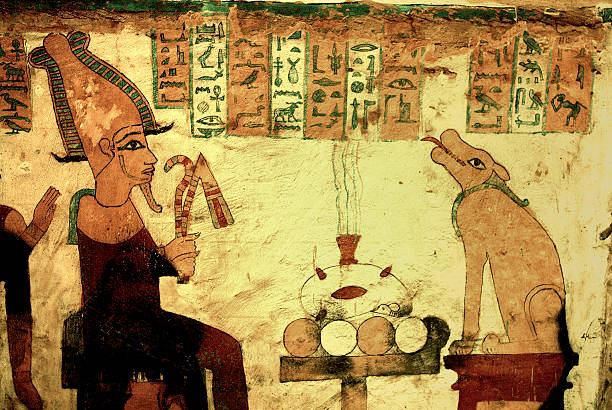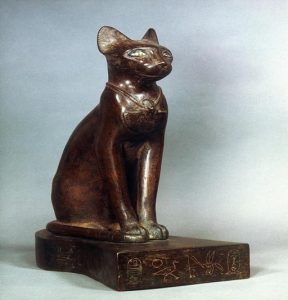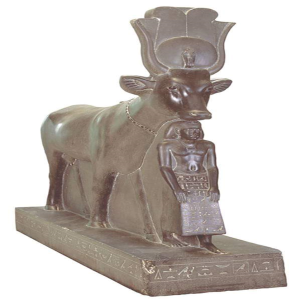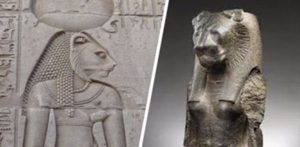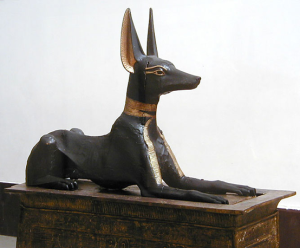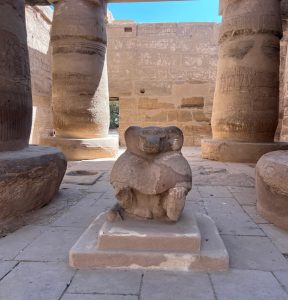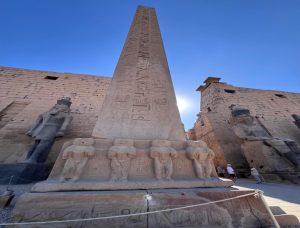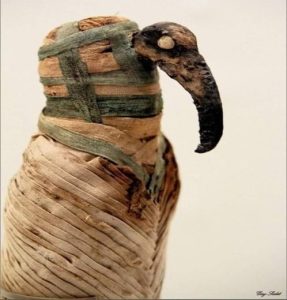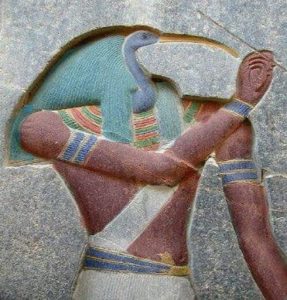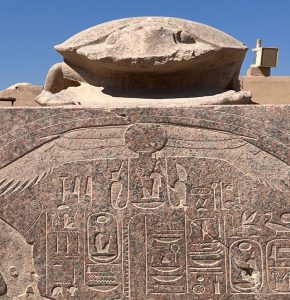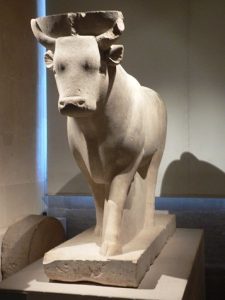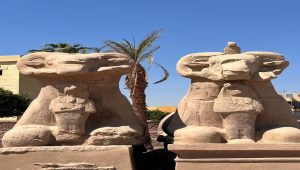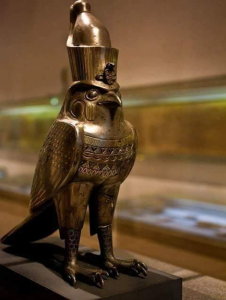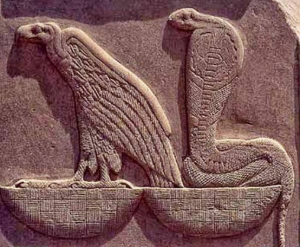The Sacred Animals of the Ancient Egyptians
The ancient Egyptians were accustomed to the presence of animals in their lives, especially since they lived in an agricultural environment. they began to benefit from some animals, such as domestic animals like cats and dogs, and farm animals like cows. There were also other animals that they feared, such as Nile crocodiles, snakes, and scorpions. Therefore, animals acquired a kind of sanctity in Egyptian life. And they came to symbolize certain divine attributes. For example, the falcon, Horus, who was characterized by loftiness and sublimity, was chosen as a symbol of royalty. The ancient Egyptians also chose the cow as a symbol of motherhood. and the ram as a symbol of fertility. And revered the crocodile out of fear of it in the Nile River because the Nile was the place of all the ancient Egyptian’s movements. In the fields, the ibis helped him purify the worm, so he considered it the god of wisdom, Thoth. Out of the ancient Egyptians’ love for animals, they buried them in their tombs since the earliest times. Then they learned mummification, they mummified them and buried them in separate tombs, the most important of which are the crocodile tombs in Kom Ombo and the Serapeum tombs in Saqqara. The Egyptians revered animals but did not worship them. Despite the cow’s attributes of motherhood, they slaughtered it and ate it because they did not revere it as a cow but revered the divine attributes in it, i.e., as a symbolic image of the god.
The Most Important Animals Revered by the Ancient Egyptians Cats
The goddess Bastet is the patroness of women during pregnancy and brings happiness to children. Therefore, the ancient Egyptians revered and buried cats with them and made a special cemetery where they mummified the bodies of cats.
STATUE OF BASTET LOUVRE MUSEUM, PARIS
The Cow
The ancient Egyptians considered cow the goddess of motherhood. Because the cow is the most affectionate of animals towards her child, giving it milk, which is the most nutritious food, and gave her the name Hathor or Isis.
The cow Hathor, one of the kings.
The Lioness Sekhmet, Wife of the Lion
The lion was a symbol of strength for the ancient Egyptians. they noticed that lioness wife was more powerful and fierce than her husband, so they took her as a symbol of war and brutality. It was revered out of fear of her. Legends say that when the sun god Ra was mocked by humans, he wanted to destroy them, so he sent the lioness who killed many of them and drank their blood.
Sekhmet, the goddess of war
The Crocodile (the god Sobek)
The ancient Egyptians feared the crocodile, so they revered it. And they called it by the name of the god Sobek in the form of a crocodile or a human body with a crocodile head. And offerings were made to him, especially in Kom Ombo and Fayoum.
Statue of Sobek and Amenhotep III – Luxor Museum
The Dog Anubis (Jackal)
The Egyptians depicted him in the form of a wolf or a dog and called him Anubis and considered him a guardian of the cemetery. Offerings were always made to him. The ancient Egyptians revered him because, as the legend says, he participated with Isis and Nephthys in mummifying the god Osiris.
Statue of Anubis from the tomb of Tutankhamun
The Monkey
The ancient Egyptians noticed that the monkey is the first to cheer at sunrise. So, they took it as a symbol of the god Thoth, the god of wisdom. And it was depicted on the base of obelisks cheering for the sunrise.
The baboon monkey (the god Thoth) in the Karnak Temple
Four monkeys on the base of the obelisk of the Karnak Temple cheering for the sunrise
The Ibis
The ancient Egyptians noticed that the ibis is one of the birds that helps them in agriculture and purifies the land from the worm. So it was considered as image of god of wisdom, Thoth. The ancient Egyptians revered it, mummified it, and built for it one of the largest bird cemeteries in the world.
Mummy of an ibis (Thoth)
The god Thoth (ibis bird)
The Scarab
The Egyptians revered the sun because it was the source of life for them. And noticed that the sun rises every morning and sets in the evening, so they considered it to be reborn every morning. The Egyptians also noticed that the scarab hatches its eggs every morning to produce new offspring, so they considered it like the sun, renewing itself every day. So it was considered as a symbol of the sun every morning and revered it, and called it the god Khepri, meaning the rising. The Egyptians also took it as an amulet to bring good luck, and this amulet still exists among Egyptians until now.
The Bull
The bull helped the ancient Egyptians in agricultural work. So it was considered as symbol of fertility. The Ancient Egyptians symbolized it with the god of agriculture, Osiris, and called him Apis and depicted him in the form of a bull or a man in the form of a bull. And it was revered in the Ptolemaic era after the Greeks united him with the god Zeus and called him the god Serapis and they built for him the greatest animal cemetery in history, the Serapeum cemetery in Saqqara.
The God Serapis in the Form of a Bull
The Ram
The ram symbolized virility and fertility for the ancient Egyptians. The ram became a symbol of the god Amun-Ra, the most important of the gods. The god Amun was depicted as a man with the form of a ram or as a ram. Every king in the New Kingdom built a temple for the god Amun-Ra in Thebes. Also, the king depicted himself with the god Amun-Ra to take strength and legitimacy of rule from him. The Egyptians also depicted the god Khnum (the potter god who shapes humans on the potter’s wheel) as a man with a ram’s head or in the form of a ram. -The god Amun-Ra in the form of a ram, and below him is a statue of King Ramses II.
The Falcon
For the ancient Egyptians, the falcon represented loftiness and nobility. Therefore, they symbolized it with the god Horus, the son of the deities Isis and Osiris, who avenged his father who was killed by his uncle Set. Horus ascended to his father’s throne, and so every king in Egypt considered himself the son of Horus on Earth. The king adopted the epithet “Horus” as one of his titles. Every king was crowned through Horus. The Egyptians also connected the god Horus with the sun god Ra, in what is known as the myth of the winged solar disk. In this myth, Horus and Ra united against their enemies, and after victory, Ra ordered that the winged solar disk (symbolizing the victory of Horus and Ra) be placed on the facade of every temple. The choice of the falcon was not arbitrary, but rather because the falcon is the only bird that does not fear the sun, but rather opens its eyes when looking at the sun. -Statue of the falcon Horus wearing the double crown, Miho Museum, Japan
The Serpent
The ancient Egyptians noticed that the serpent, because it has no eyelids, does not close its eyes when sleeping. It is also one of the most capable animals of hiding and changing its skin, and for this reason, he revered it. Among the most important deities depicted in the form of a serpent are the goddess Wadjet (the protective goddess of the king in his life), the god Mehen, the goddess Mert Seger, also, the god Apophis, the eternal enemy of the sun boat. the serpent was always associated with renewal and rebirth. Therefore, it was always depicted in tombs as a guardian of tombs. -Image of the two protective goddesses of the king (the serpent Wadjet / the female vulture Nekhbet)
The Scorpion
The most dangerous animal of all. Because one sting means death. For this reason, a goddess was taken from it and named Selket. Selket is considered one of the protective goddesses of the deceased. She was drawn on the coffin of the deceased as one of the four guardians of the deceased (Selket – Neith – Isis – Nephthys).

